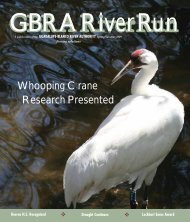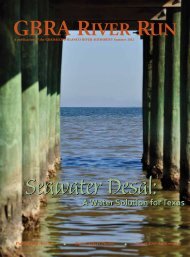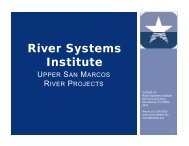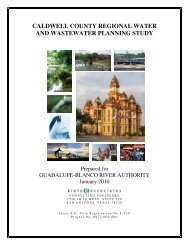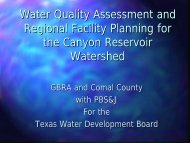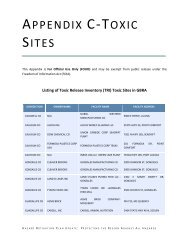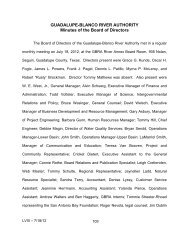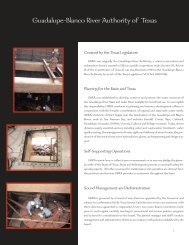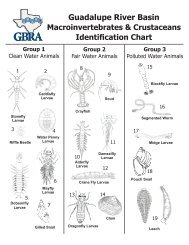Fall 2012 - Guadalupe-Blanco River Authority
Fall 2012 - Guadalupe-Blanco River Authority
Fall 2012 - Guadalupe-Blanco River Authority
You also want an ePaper? Increase the reach of your titles
YUMPU automatically turns print PDFs into web optimized ePapers that Google loves.
Work Plan for the Texas Instream FlowProgram Progressesby Debbie MaginHow much water do Texas rivers and streams need? Inresponse to that question, Senate Bill 2 (SB2) was passed in2001. The legislation directed the state “to conduct studies andanalyses to determine appropriate methodologies for determiningflow conditions in the state’s rivers and streams necessary tosupport a sound ecological environment.” The agencies assignedthese tasks were the Texas Water Development Board (TWDB),the Texas Commission on Environmental Quality (TCEQ) and theTexas Parks and Wildlife Department (TPWD). In response to thedirectives in SB2 the three agencies developed the Texas InstreamFlow Program (TIFP). In 2005 the National Academies of Sciencereviewed the TIFP and found that it conforms to best scientificpractices and will provide “enormous benefits to the state.”Achieving the goal of the legislation to determine flows that willsupport healthy aquatic communities requires a multidisciplinaryapproach. The TIFP looks at water quality, hydrology andhydraulics, biology, connectivity to the riparian environment andthe physical processes at work in the streams. To maintain a soundecological environment within a stream requires not one flow buta “flow regime.” Flow components such as pulse flows that movedetritus, overbank flows that bring in nutrients, subsistence flowsthat can support the aquatic community during times of drought,along with base flows, are needed to provide a healthy aquaticenvironment. For each river basin or sub-basin, TIFP conducts sitespecific studies in order to determine flow-ecology relationshipsfor each of these flow regime components. Since 2007, studies areongoing in the Lower San Antonio and Middle and Lower Brazos<strong>River</strong> sub-basins.Over the next three years, the state agencies, along with GBRA,will conduct the TIFP study of the lower <strong>Guadalupe</strong> <strong>River</strong>. Thestudy process includes data collection and evaluation, both ofcurrent data measured in the streams as well as the historicaldata collected by other scientific efforts, such as the Clean<strong>River</strong>s Program and the U.S. Geologic Survey. Along the way,stakeholders in the <strong>Guadalupe</strong> <strong>River</strong> Basin will have multipleopportunities to help develop the goals of the study, review thefindings and inquire about what is being done on their river. Thefirst two public meetings will be held in January 2013. The processwill include peer review by other knowledgeablescientists that work in the fields of aquatic biology, hydrologyand geomorphology.The timing of the SB2 TIFP study of the lower <strong>Guadalupe</strong> <strong>River</strong>is right. In 2007, Senate Bill 3 (SB3) was passed and formallyestablished the Environmental Flow Allocation Process, a processto rapidly determine the amount of flow necessary to providefor a sound ecological environment in the streams and baysand estuaries.The SB3 process relied on the best available science tomake recommendations, but includes an adaptive managementprocess to refine environmental standards as additional studiesare completed or conditions change. The SB3 process forthe <strong>Guadalupe</strong>/San Antonio and Mission/Aransas <strong>River</strong>s wascompleted in <strong>2012</strong> and the stakeholders who representedindustries, municipalities, environmental interest groups, riverauthorities, agriculture and both commercial and recreationalfishing, have provided TCEQ with recommended flow regimes forboth instream and inflow into San Antonio Bay. The stakeholdersalso identified a work plan of studies and projects that are neededto reevaluate and adapt the flow needs as the basins change withtime. The top priority in that work plan is the completion of theTIFP study on the <strong>Guadalupe</strong> <strong>River</strong>.The TIFP on the lower <strong>Guadalupe</strong> <strong>River</strong> will get started in early2013, with several public meetings. Stakeholders will have theopportunity to help set the goals of the study. Preliminary workhas already begun to gather baseline fish data, sample sediments,evaluate riparian areas, and develop water quality models. Workhas already been completed to evaluate historical fish data fortrends, look at floodplain lake formation and dynamics, segmentthe river based on geomorphic characteristics, determine habitatrequirements of Golden Orb and review literature describingprevious work that has been completed in the basin, all of whichwill be used to develop an instream flow study design specific tothe Lower <strong>Guadalupe</strong> <strong>River</strong> Basin.GBRA <strong>River</strong> Run <strong>Fall</strong> <strong>2012</strong>7




